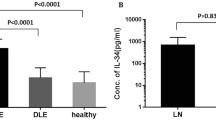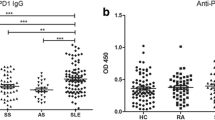Abstract
The serum level of soluble Fas (sFas) molecules in 35 patients with SLE was determined by enzyme-linked immunosorbent assay (ELISA) and its relation to other lymphocyte activation markers and clinical parameters was examined. The level of sFas increased significantly compared to that in normal subjects, consistent with previous reports. There was a significant correlation between the level of sFas and that of sCD4, suggesting some relation between sFas and activation of CD4+ T cells. Patients with lymphopenia tended to have low levels of sFas, making it possible to hypothesize that sFas protects against apoptosis. Although the change in the level of sFas with steroid therapy was variable, some relation to the differential activation of T cell subsets was suggested.
Similar content being viewed by others
References
Russell JH, White CL, Loh DY, Meleedy-Rey P: Receptor-stimulated death pathway is opened by antigen in mature T cells. Proc Natl Acad Sci USA 88:2151–2155, 1991
Itoh N, Yonehara S, Ishii A, Yonehara M, Mizushima S, Sameshima M, Hase A, Seto Y, Nagata S: The polypeptide encoded by the cDNA for human cell surface antigen Fas can mediate apoptosis. Cell 66:233–243, 1991
Watanabe-Fukunaga R, Brannan CI, Itoh, N, Yonehara S, Copeland NG, Jenkins NA, Nagata S: The cDNA structure, expression, and chromosomal assignment of the mouse Fas antigen. J Immunol 148:1274–1279, 1992
Oehm A, Behrmann I, Falk W, Pawlita M, Maier G, Klas C, Li-Weber M, Richards S, Dhein J, Trauth BC, Ponsting H: Purification and molecular cloning of the APO-1 cell surface antigen, a member of the tumor necrosis factor/nerve growth factor receptor superfamily. J Biol Chem 267:10709–10715, 1992
Itoh N, Nagata S: A novel protein domain required for apoptosis. J Biol Chem 268:10932–10937, 1993
Alderson MR, Tough TW, Davis-Smith T, Braddy S, Falk B, Schooley KA, Goodwin RG, Smith CA, Ramsdell F, Lynch DH: Fas ligand mediates activation-induced cell death in human T lymphocytes. J Exp Med 181:71–77, 1995
Ju S, Panka DJ, Cui H, Ettinger R, El-Khatib M, Sherr DH, Stanger BZ, Marshak-Rothstein: Fas(CD95)/FasL interactions required for programmed cell death after T-cell activation. Nature 373:444–448, 1995
Watanabe-Fukunaga R, Brannan CI, Copeland NG, Jenkins A, Nagata S: Lymphoproliferation disorder in mice explained by defects in Fas antigen that mediates apoptosis. Nature 356:314–317, 1992
Emlen W, Niebur J, Kadera R: Accelerated in vitro apoptosis of lymphocytes from patients with systemic lupus erythematosus. J Immunol 152:3685–3692, 1994
Cheng J, Zhou T, Liu C, Shapiro JP, Brauer MJ, Kiefer MC, Barr PJ, Mountz JD: Protection from Fas-mediated apoptosis by a soluble form of the Fas molecle. Science 263:1759–1762, 1994
Yu DTY, Winchester RJ, Fu SM, Gibfsky A, Ko HS, Kunkel HG: Peripheral blood Ia-positive T cells. Increases in certain diseases and after immunization. J Exp Med 151:91–100, 1980
Tokano Y, Murashima A, Takasaki Y, Hashimoto H, Okumura K, Hirose S: Relation between soluble interleukin 2 receptor and clinical findings in patients with systemic lupus erythematosus. Ann Rheum Dis 48:803–809, 1989
Tokano Y, Hishikawa T, Hirose T, Sekigawa I, Hashimoto H, Okumura K, Hirose S: HLA-DP-positive T cells in patients with systemic lupus erythematosus. Autoimmunity 5:179–183, 1990
Murashima A, Takasaki Y, Ohgaki M, Hashimoto H, Shirai T, Hirose S: Activated peripheral blood mononuclear cells detected by murine monoclonal antibodies to proliferating cell nuclear antigen in active lupus patients. J Clin Immunol 10:28–37, 1990
Sawada S, Hashimoto H, Iijima S, Tokano Y, Takei M, Shida M, Obara T: Immunologic significance of increased soluble CD8/CD4 molecules in patients with active systemic lupus erythematosus. J Clin Lab Anal 7:141–146, 1993
Yoshikawa T, Nanba T, Kato H, Hori K, Inamoto T, Kumagai S, Yodoi J: Soluble FcεRII/CD23 in patients with autoimmune diseases and Epstein-Barr virus-related disorders: Analysis by ELISA for soluble FcεRII/CD23. Iramunomethods 4:65–71, 1994
Tan EM, Cohen AS, Fries JF, Masi AT, McShane DJ: The 1982 revised criteria for the classification of systemic lupus erythematosus. Arth Rheum 25:1271–1277, 1982
Liang WH, Socher SA, Larson MG, Schur PH: Reliability and validity of six systems for the clinical assessment of disease activity in systemic lupus erythematosus. Arth Rheum 32:1107–1118, 1989
Cifone MG, Maria RD, Roncaioli P, Rippo MR, Azuma M, Lanier LL, Santoni A, Testi R: Apoptotic signaling through CD95 (Fas/Apo-1) activates an acidic sphingomyelinase. J Exp Med 177:1547–1552, 1994
Winfield JB, Winchester RJ, Kunkel HG: Association of cold-reactive antilympocyte antibodies with lymphopenia in systemic lupus erythematosus. Atrh Rheum 18:587–594, 1975
Amasaki Y, Kobayashi S, Takeda T, Ogura N, Jodo S, Nakabayashi T, Tsutsumi A, Fujisaku A, Koike T: Up-regulated expression of Fas antigen (CD95) by peripheral naive and memory T cell subsets in patients with systemic lupus erythematosus (SLE): A possible mechanism for lymphopenia. Clin Exp Immunol 99:245–250, 1995
Knipping E, Krammer PH, Onel KB, Lehman TJA, Mysler E, Elkon KB: Levels of soluble Fas/Apo-1/CD95 in systemic lupus erythematosus and juvenile rheumatoid arthritis. Arth Rheum 38:1735–1737, 1995
Goel N, Ulrich DT, Clair WS, Fleming JA, Lynch DH, Seldin MF: Lack of correlation between serum soluble Fas/Apo-1 levels and autoimmune disease. Arth Rheum 38:1738–1743, 1995
Ettinger R, Panka DJ, Wang JKM, Stanger BZ, Ju S, Marshak-Rothstein A: Fas ligand-mediated cytotoxicity is directly responsible for apoptosis of normal CD4+ T cells responding to a bacterial superantigen. J Immunol 154:4302–4308, 1995
Author information
Authors and Affiliations
Rights and permissions
About this article
Cite this article
Tokano, Y., Miyake, S., Kayagaki, N. et al. Soluble Fas molecule in the serum of patients with systemic lupus erythematosus. J Clin Immunol 16, 261–265 (1996). https://doi.org/10.1007/BF01541390
Accepted:
Issue Date:
DOI: https://doi.org/10.1007/BF01541390




